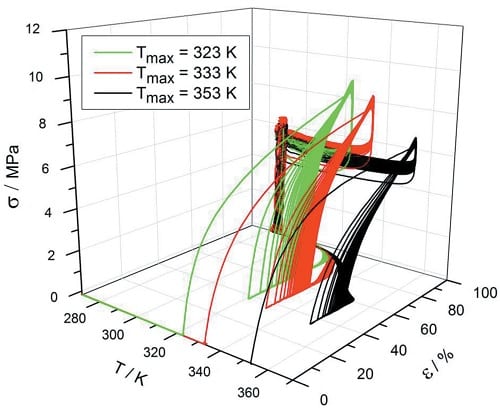Shape memory polymers (SMPs) are polymeric smart materials that have the ability to return from a deformed state to their original shape. This class of polymers can retain two or sometimes three shapes, and the transition between those is mostly induced by temperature. SMPs have received considerable attention in medical technology, but so far little interest as engineering applications are concerned. This seems to be unfortunate because polymers are easy to process. Shape memory polymers can also help to reduce weight and they show a good corrosion and wear resistance.
One reason for the limited success that shape memory polymers have met in engineering may be the lack of structural and functional data. The majority of earlier studies on thermally activated SMPs have focused on synthesis and characterization of these materials, tuning and optimization of their shape memory properties as well as their biocompatibility and biodegradability.
Engineering applications, however, require shape memory polymers with enhanced mechanical properties, high recovery stresses and good reproducibility of shape fixity and shape recovery in multiple cycles. There is a need of shape memory polymers that are both materially stable and resistant to functional fatigue.
 Therefore, a group of researchers from the Ruhr-Universität Bochum, Germany, conducted a comprehensive experimental study of the mechanical and shape memory properties. Safa Mogharebi et al. investigated a specific thermoplastic polyurethane based shape memory polymer in the temperature-stress-strain space and its possibility of repeating programming cycles.
Therefore, a group of researchers from the Ruhr-Universität Bochum, Germany, conducted a comprehensive experimental study of the mechanical and shape memory properties. Safa Mogharebi et al. investigated a specific thermoplastic polyurethane based shape memory polymer in the temperature-stress-strain space and its possibility of repeating programming cycles.
They focused on parameters which characterize the functional fatigue and material stability of the tested polymer during consecutive cycles. Several parameters were evaluated from the raw data which reveal how the shape recovery is affected by thermal cycling and programming temperature. The findings not only give a better understanding of this material class. They clearly show the potential of SMPs for actuator applications in engineering. Safa Mogharebi et al. conclude that the results of the study represent a starting point for further work that is required to promote the use of shape memory polymers.

















